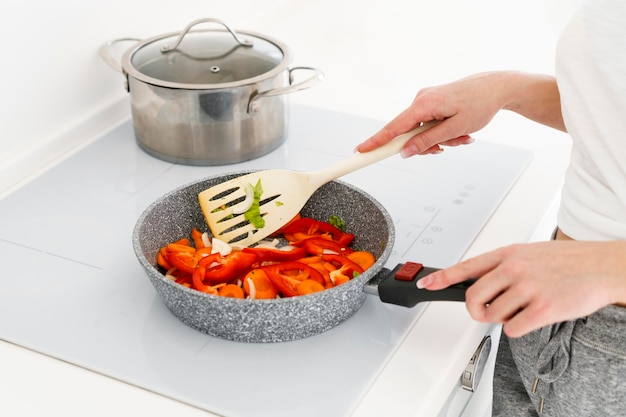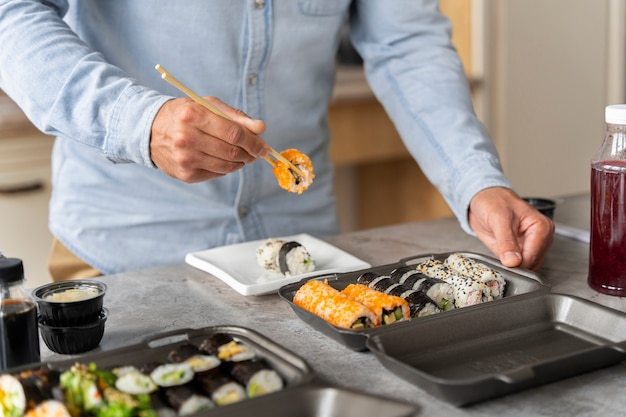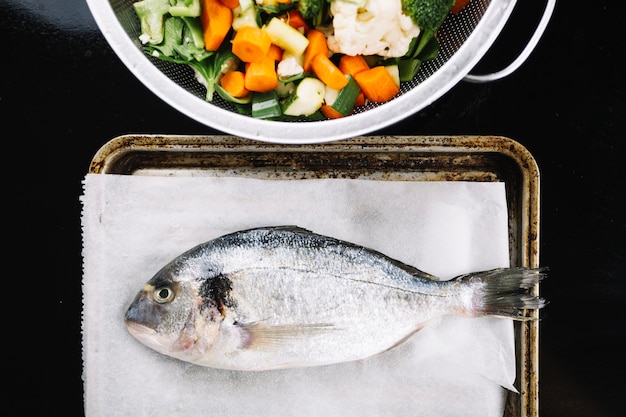Let's be honest, sometimes we crave something delicious and satisfying, but the thought of slaving over a hot stove for hours just doesn't appeal. That's where this easy stovetop mahi mahi recipe comes in. It's all about simplicity, flavour, and minimal fuss, perfect for those nights when you want a tasty meal without a lot of effort.
I've been making this recipe for years, and it never fails to impress. It's become a staple in my family's rotation, and even my notoriously picky teenage son will clean his plate with this one. You might be thinking, "I can't possibly cook fish that well." But trust me, this recipe is so easy, even a complete novice can pull it off.
(Part 1) The Right Ingredients for Success

Choosing the Star: Mahi Mahi
First things first, you need to find yourself some mahi mahi. Fresh is always best, and if you have a local fishmonger, I highly recommend heading there. There's simply no substitute for the taste and texture of a truly fresh fish. But if you're not near a fishmonger, frozen mahi mahi will do just fine.
Here's how to choose the best:
Fresh: Look for fillets that are firm, have a nice, even colour (usually light pink to white), and are free of any fishy odor. They should be moist and have a slightly glistening appearance.
Frozen: Look for frozen mahi mahi that's individually wrapped. This helps to prevent freezer burn and keeps the fish fresher for longer. Again, check for a firm texture and avoid any discoloration.
The Supporting Cast: Essential Ingredients
This recipe is all about letting the mahi mahi shine, so we're not overloading it with fancy ingredients. Here's a rundown of what you'll need:
Olive oil: This is your base for searing the fish. Look for a good quality extra virgin olive oil that has a nice fruity flavour.
Butter: A bit of butter at the end adds a lovely richness and sheen to the fish. I like to use unsalted butter, but salted will work fine too. Just adjust the seasoning accordingly.
Salt and pepper: The seasoning essentials for any good dish. Freshly ground black pepper is ideal.
Lemon: A squeeze of lemon juice adds a bright, fresh acidity that cuts through the richness of the fish.
Fresh herbs: I love to use parsley and dill, but feel free to experiment with other herbs like basil, thyme, or oregano.
(Part 2) Gathering Your Equipment

Here's what you'll need to create your masterpiece:
Non-stick frying pan: This is crucial for getting that beautiful golden crust without the fish sticking. Look for a pan with a thick bottom and good heat distribution.
Spatula: A good quality spatula is essential for flipping the fish without breaking it. Look for one with a flexible blade that won't scrape the pan.
Sharp knife: You'll need a sharp knife for slicing the fish into even pieces. A good chef's knife or a filleting knife will do the trick.
Kitchen timer: This ensures that your fish doesn't get overcooked.
Mixing bowls: You'll need a few bowls for mixing ingredients and prepping the fish.
(Part 3) The Art of Searing

Prepping the Fish
1. Pat dry: Start by gently patting your mahi mahi fillets dry with paper towels. This will help them brown nicely and prevent them from steaming in the pan.
2. Season generously: Now, season the fillets generously with salt and pepper. Be sure to season both sides evenly. If the skin is still on, season that side too.
The Searing Process: Step-by-Step
1. Heat the pan: Place your non-stick frying pan over a medium-high heat. Add a generous amount of olive oil, enough to coat the bottom of the pan. The oil should be hot enough to sizzle when you add the fish.
2. Place the fish: Carefully place the mahi mahi fillets in the hot pan, making sure they're not crowded. Leave them undisturbed for about 3-4 minutes. You want to let them develop a beautiful golden-brown crust.
3. Flip it over: Once the first side is nicely browned, use your spatula to gently flip the fillets. Try not to break them.
4. Cook the other side: Cook the second side for another 3-4 minutes, or until the fish is cooked through. You can test for doneness by gently pressing the flesh with a finger. It should flake easily if it's cooked through. The flesh should be opaque, not translucent.
The Finishing Touches
1. Add the butter: Once the mahi mahi is cooked, add a knob of butter to the pan. The butter will melt and create a lovely, rich sauce.
2. Citrus burst: Squeeze a generous amount of lemon juice over the fish.
3. Herby goodness: Sprinkle with your chosen fresh herbs.
(Part 4) Serving Suggestions
Mahi mahi is incredibly versatile and pairs well with a variety of side dishes. Here are a few ideas:
Light and Summery:
Mixed green salad with light vinaigrette: This is a classic pairing that highlights the fresh flavours of the fish.
quinoa salad with roasted vegetables: A healthy and satisfying option that adds a bit of complexity to your meal.
grilled corn on the cob: The sweet corn complements the delicate flavour of the mahi mahi.
More Substantial Sides:
Roasted potatoes: A classic comfort food that pairs beautifully with the fish.
Rice: A simple and versatile side that absorbs the flavour of the lemon juice and butter.
steamed asparagus or green beans: Adding some green vegetables to your plate balances the richness of the fish.
Wine Pairing
For the perfect wine pairing, consider:
Crisp white wine: A Sauvignon Blanc or Pinot Grigio will complement the delicate flavour of the mahi mahi.
Light-bodied red wine: A Pinot Noir is a good choice for those who prefer red wine.
(Part 5) Mastering the Art of Freshness
As I mentioned before, fresh mahi mahi is the ideal choice. But if you're not able to get your hands on fresh, don't despair! Frozen mahi mahi can still be delicious, as long as you choose a quality brand and thaw it properly. Here's how:
Thawing: The best way to thaw frozen fish is in the refrigerator. Place it on a plate or in a container and let it thaw for several hours, or overnight. Never thaw fish at room temperature.
If you're using frozen mahi mahi, you can enhance its flavour by marinating it for a few hours before cooking. This helps to add moisture and flavour to the fish. Here's a simple marinade recipe:
Ingredients: 1/4 cup olive oil, 2 tablespoons lemon juice, 1 tablespoon chopped fresh herbs (parsley, dill, or thyme), 1 teaspoon salt, 1/2 teaspoon black pepper.
Instructions: Combine the ingredients in a bowl and whisk together. Pour the marinade over the fish and let it marinate in the refrigerator for 2-4 hours.
(Part 6) Variations on the Recipe: Get Creative!
Don't be afraid to experiment with this basic recipe! Here are a few ideas to add your own personal touch:
Spice It Up:
Spicy kick: Add a pinch of cayenne pepper or a few slices of jalapeno pepper to the pan while searing the fish.
Gochujang glaze: For a bolder flavor, try a gochujang glaze (a Korean chili paste).
Citrus Infusion:
Orange zest and juice: Add some orange zest and juice to the pan for a refreshing citrusy twist.
Grapefruit zest and juice: For a more tart and tangy flavour, use grapefruit zest and juice.
Herbs Galore:
Mediterranean flair: Try using fresh oregano, basil, and thyme for a Mediterranean flavour profile.
Aromatic blend: Combine rosemary, sage, and garlic for a rich and earthy flavor.
(Part 7) Tips for Success: Ensuring a Perfect Mahi Mahi
Here are a few tips to ensure that your mahi mahi turns out perfectly every time:
Don't overcook the fish: The key to perfectly cooked mahi mahi is to avoid overcooking it. Overcooked fish becomes dry and tough.
Use a good quality pan: A good non-stick pan makes all the difference in ensuring that the fish doesn't stick and develops a beautiful golden crust.
Don't overcrowd the pan: Make sure that the fillets have enough space to brown properly.
Flip only once: Avoid flipping the fish multiple times as this can break it up.
Let the fish rest: After cooking, let the fish rest for a few minutes before serving. This allows the juices to redistribute and prevents the fish from becoming dry.
(Part 8) My Mahi Mahi Story: A Personal Touch
I remember the first time I made this recipe. I was nervous, as I wasn't a confident cook back then. But the recipe was so easy to follow, and the results were absolutely delicious. It was such a hit with my family, and it became a regular fixture on our dinner table. I even brought it to a friend's dinner party and it was a huge success. It was a testament to how simple, yet impressive this dish can be.
(Part 9) Beyond the Recipe: Mahi Mahi's Versatility
Mahi mahi isn't just great for pan-searing. It's a versatile fish that can be cooked in many different ways. Here are a few ideas:
Baking: Simply place the fillets on a baking sheet lined with parchment paper and bake in a preheated oven at 375°F (190°C) for 12-15 minutes.
Grilling: Preheat your grill to medium heat and cook the fillets for 4-5 minutes per side.
Roasting: Place the fillets on a baking sheet and roast in a preheated oven at 400°F (200°C) for 10-12 minutes.
Tacos: Flake cooked mahi mahi and use it as a filling for tacos.
Sandwiches: Grilled mahi mahi makes a delicious and healthy sandwich filling.
Salads: Add flaked mahi mahi to your favourite salads for a protein boost.
(Part 10) The Health Benefits of Mahi Mahi: A Nutrient Powerhouse
Besides being delicious, mahi mahi is also a healthy choice. It's a good source of:
Protein: Mahi mahi is a great source of lean protein, which is essential for building and repairing tissues.
Omega-3 fatty acids: These fatty acids are known to support heart health and brain function.
Vitamin D: Mahi mahi is a good source of vitamin D, which is essential for bone health and immune function.
(Part 11) FAQs: Your Questions Answered
1. Can I substitute mahi mahi with another fish?
Yes, you can substitute mahi mahi with other white fish like cod, halibut, or snapper. Just be sure to adjust the cooking time accordingly. Cod and snapper will cook a bit faster than mahi mahi, while halibut might take a bit longer.
2. What if I don't have fresh herbs?
Dried herbs can be a good substitute. Just remember to use a little less, as dried herbs are more concentrated than fresh.
3. Can I grill the mahi mahi instead of pan-searing it?
Absolutely! Grilling is a great way to cook mahi mahi. Preheat your grill to medium heat and cook the fillets for about 4-5 minutes per side.
4. How do I know if the mahi mahi is cooked through?
You can tell if the mahi mahi is cooked through by gently pressing the flesh with a finger. It should flake easily and the flesh should be opaque. You can also use a meat thermometer to check the internal temperature. It should be at least 145°F (63°C).
5. Can I make this recipe ahead of time?
You can definitely cook the mahi mahi ahead of time, but it's best to serve it immediately after cooking. If you do cook it ahead of time, reheat it gently in the oven or microwave.
So, there you have it: a simple, delicious, and healthy recipe for pan-seared mahi mahi. Go forth and impress your friends and family with this culinary masterpiece!
Everyone is watching

Corn on the Cob: The Ultimate Guide to Perfectly Cooked Ears
Healthy MealsAh, corn on the cob. Just the name evokes images of sunny days, barbecues, and that sweet, juicy flavour that ...

Perfect Pork Roast Oven Cooking Time: A Guide to Delicious Results
Healthy MealsThere's something truly satisfying about a perfectly roasted pork. The aroma alone is enough to make your mout...

Ham Cooking Time: How Long to Bake, Smoke, or Boil a Delicious Ham
Healthy MealsAh, ham. It's a classic, isn't it? A real crowd-pleaser, especially around holidays. And when done right, it'...

Scallops: The Ultimate Guide to Perfect Cooking
Healthy MealsAh, scallops. Those delicate, sweet, and utterly delicious morsels of the sea. They hold a special place in my...

Spaghetti Squash: The Ultimate Guide to Cooking and Serving
Healthy MealsRemember that time you saw spaghetti squash at the supermarket, looking all bumpy and strange, and thought, "W...
